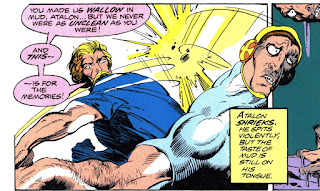Killraven: Warrior of the Worlds
Marvel Epic Collection, 2021
Marvel Epic Collection, 2021
'Killraven: Warrior of the Worlds' was published in 2021. As an entry in Marvel's 'Epic Collection' imprint, it's designed to be an affordable trade paperback reprinting the comic books of the 1970s that featured the Killraven character. In the 504 pages of this Epic Collection, you get all of Killraven's entries in Amazing Adventures from issue 18 (May 1973) to 39 (November 1976). Also bundled in the book are the May, 1976 issue of Marvel Team-Up featuring Spider-Man and Killraven, and the 1983 Killraven graphic novel, 'Last Dreams Broken'.
The last section of the Epic Collection contains various editorial essays, draft script and art pages, and Marvel encyclopedia entries for Killraven and his allies. In his editorial essay for the debut of Killraven in Amazing Adventures #18, Roy Thomas reveals that he first conceived of the character in 1971, but his pressing writing and editorial duties kept him from presenting Killraven until two years later.
One thing that should be noted is that the comics in the Epic Collection are recolored and are significantly brighter than those of the original comics. Purists might object to this process, but even making allowances for the inevitable fading of the original comic, in the scans compared below, I think the recolored version is better:
The Killraven stories had a level of violence, and gruesome deaths, that stretched the boundaries of a Comics Code book of the mid-1970s, which added to its hip quality. The mutants and monsters and villains in the pages of Killraven had no qualms about snuffing out Earthlings in order to bring about the subjugation of the planet at the hands - or rather, tentacles - of the Martian invaders.
Indeed, in issue #27 (November 1974) readers learned of a facility where human females were housed in cages and regularly impregnated by their hapless husbands, so that their infants could be served up to the Martians as culinary delicacies - ! Pretty strong stuff for a superhero comic, back in the day.
The Killraven saga also offered some eccentric content that could only have been approved in the 1970s, such as the episode where Killraven encountered an underground city peopled by blacks who had fled the Martian invasion in order to establish a blacks-only realm, free of white racism.
When Killraven stumbled across the city, its inhabitants were none too pleased to see him...........written by white writer Bill Mantlo, the story featured dialogue that exemplified 70s Black Power !
The initial issues of the Killraven storyline were straightforward sci-fi adventure, and well illustrated by Marvel veteran Herb Trimpe. But with Amazing Adventures No. 27 (November 1974) P. Craig Russell joined as the permanent artist. Russell's artwork, with its Art Deco / Art Nouveau sensibilities, made Killraven stand out from Marvel's other titles.
Unfortunately, with issue 27, writer Don McGregor's proclivities to overwrite were given free rein, a decision that was to handicap the remaining two years of the series.
Too often, Russell's ornate pencils, and the imaginative color schemes of a revolving cast of colorists, were overwhelmed by McGregor's pretentious verbiage.
The plots became more contrived and unconvincing, and divorced from the 'war with the Martians' theme, in order for McGregor to demonstrate that, even though comics books are for juveniles, he was an immense literary talent who rose above the limitations of the medium.
The 1983 graphic novel is a disappointment. The opportunity to tie up some loose threads plot-wise is available, but McGregor can't resist overwriting things, and too many panels are burdened with excessive speech balloons, too many of which are stuffed with grandiloquent text.
The verdict ? If you are a Baby Boomer, like me, and you want to recapture the fun of encountering the Killraven storyline once again, then the Epic Collection is a very affordable way to do so. Just be prepared to see the writing for the series evolve from sci-fi fun, to self-indulgent circumlocutions.
The art, however, remains strong even after the passage of nearly 50 years.





















_0000.jpg)

















1 comment:
I loved the McGregor/Russell Killraven at the time. Russell's art was a revelation, and McGregor's writing was exactly the kind of thing that 14- & 15-year-old comics/science fiction/fantasy fanboys always love. Yes, in hindsight it was awful, but it was a lot more involving and exciting than any superhero stuff that was around at the time (with the honourable exception of Steve Gerber's Defenders. Gerber was brilliant). I remember these Killraven issues very fondly, especially "Only the Computer Shows me any Respect."
Post a Comment